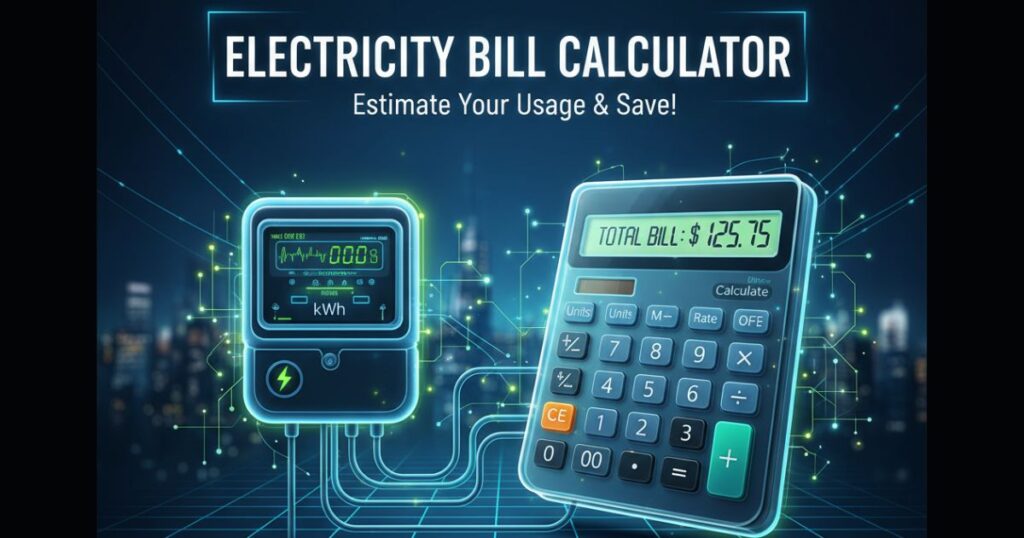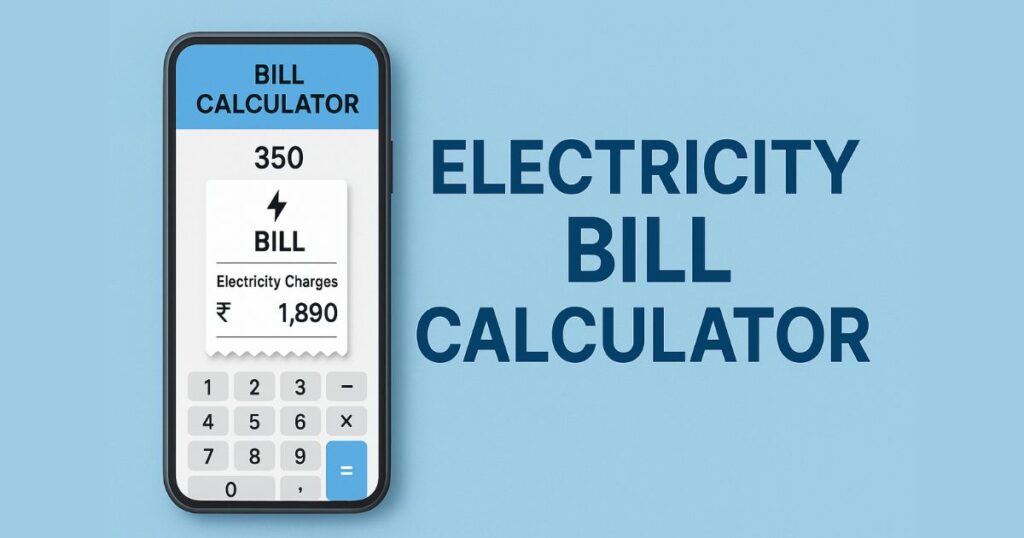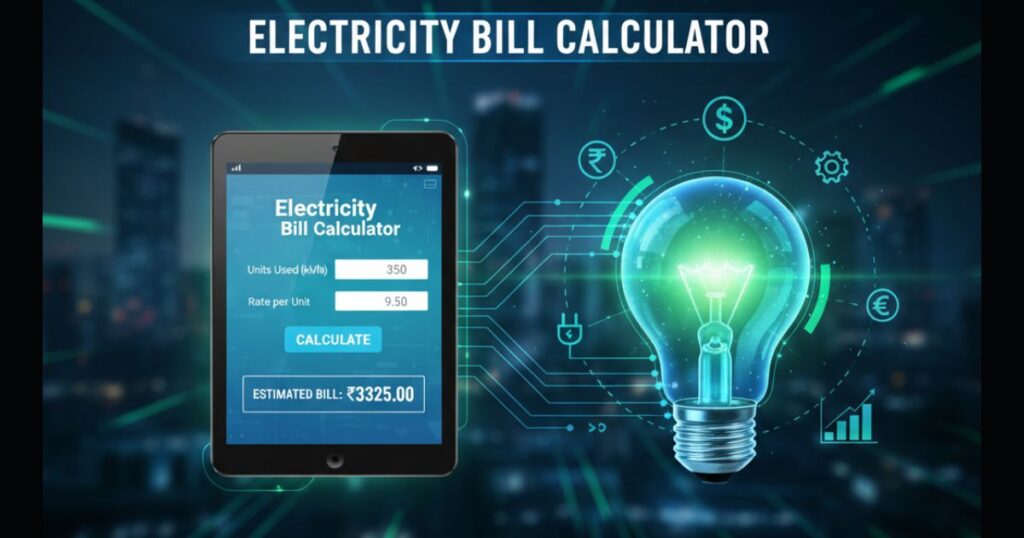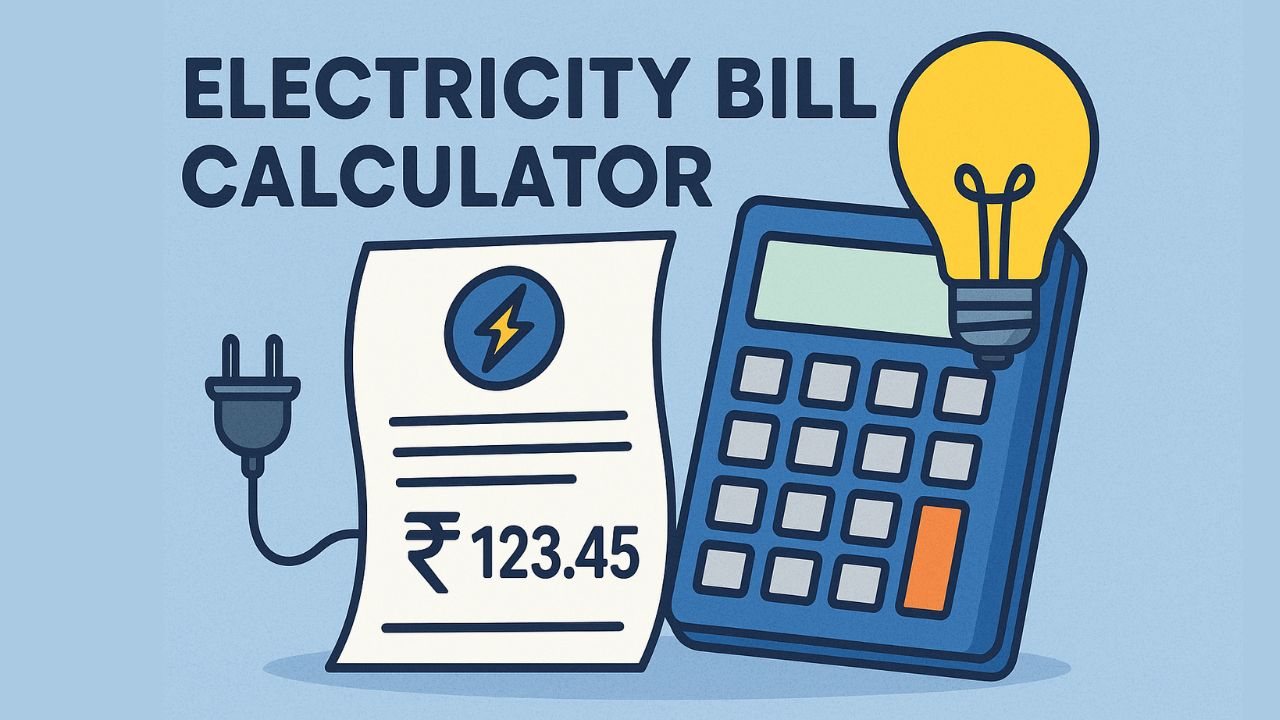Have you ever opened your electricity bill and felt like you were staring at a puzzle? Those numbers for units consumed, fixed charges, and duties can be confusing, right? If you’re in India, where tariffs change from state to state, it’s even trickier. That’s where an electricity bill calculator comes in handy.
It’s a simple tool that helps you figure out your monthly costs without the headache. In this blog, we’ll dive into what these calculators are, how they work, and why you should use one. I’ll keep things straightforward so you can follow along easily.
Imagine planning your budget better or spotting ways to cut down on power use. That’s the goal here. We’ll look at real examples from different states, break down the math, and share tips to save money.
What Is an Electricity Bill Calculator?
An electricity bill calculator is basically an online tool that estimates your power bill based on your usage and location. It takes inputs like how many units you’ve used, your state or electricity board, and the type of connection you have—whether it’s for your home, shop, or factory. The best ones, like the one we’ll talk about, pull in current tariff rates to give you a spot-on calculation.
These tools aren’t new, but they’ve gotten smarter with updates. They factor in things like slab rates, where the price per unit jumps as you use more power. Plus, they add in fixed charges based on your connection strength and even taxes like electricity duty. No more guessing or waiting for the bill to arrive.
Why bother with one? Well, it helps you predict costs ahead of time. If you’re moving to a new city, you can compare rates. Or if you’re a business owner, it lets you budget for commercial rates, which are often higher. It’s all about making informed choices without needing a degree in accounting.
How Electricity Bills Are Calculated in India
Electricity billing in India isn’t one-size-fits-all. Each state has its own regulatory body that sets the rules. For example, in Delhi, it’s the Delhi Electricity Regulatory Commission (DERC), while in Maharashtra, it’s the Maharashtra State Electricity Distribution Co. Ltd. (MSEDCL). These groups decide the rates based on factors like power generation costs and local demands.
The main parts of your bill are energy charges, fixed charges, and duties. Energy charges depend on units consumed, measured in kilowatt-hours (kWh). Fixed charges are like a subscription fee, based on your connection load in kilowatts (kW). Then there’s electricity duty, usually a percentage of the total.
Let’s break it down further. Most states use a slab system for domestic users. Say you use 150 units in a month. The first 100 might cost ₹4 per unit, and the next 50 ₹6 per unit. It’s progressive, encouraging you to use less.

For commercial and industrial setups, it’s different. They might have flat rates or extra fees for peak hours. Industrial users often pay more because they need reliable, high-volume power.
Understanding this helps you see why your bill fluctuates. Seasonal changes, like using AC in summer, can push you into higher slabs.
Key Features of a Good Electricity Bill Calculator
Not all calculators are created equal. A solid one should cover multiple states—over 30 in India, from Delhi to remote areas like Lakshadweep. It needs options for consumer types: domestic, commercial, or industrial.
Look for inputs like units consumed, previous and current meter readings (to auto-calculate units), and connection load. The output should show breakdowns: energy charges, fixed charges, duty, and total amount.
In the calculator we’re referencing, it’s user-friendly with a clean design. You pick your board from a dropdown, enter details, and hit calculate. Results pop up in a neat grid, making it easy to read.
It even handles optional fields gracefully. If you input meter readings, it figures out units for you. That’s a time-saver!
Security-wise, good calculators run locally in your browser, so no data gets sent out. Your info stays private.
Step-by-Step Guide to Using the Calculator
Ready to try it? Here’s how it works, based on a typical online tool.
First, select your electricity board. Options include big ones like TNEB for Tamil Nadu or BESCOM for Bangalore.
Next, choose your consumer type. Domestic for homes, commercial for businesses, industrial for factories.
Enter units consumed. If you have meter readings, plug them in—previous and current. The tool subtracts them to get units.
Add your connection load, usually in kW. Default might be 2 kW for homes.
Hit the calculate button. Boom! You get a breakdown.
For example, let’s say you’re in Delhi, domestic, 250 units, 2 kW load.
- First 200 units at ₹3/unit: ₹600
- Next 50 at ₹5/unit: ₹250
- Fixed charge: ₹25 * 2 = ₹50 (approx.)
- Duty: 6% of energy charges: ₹51
- Total: Around ₹951
It’s that simple. Play around with numbers to see how cutting usage saves money.
Benefits of Using an Electricity Bill Calculator
Why use this over just waiting for your bill? For starters, it’s proactive. You can estimate costs before the month ends and adjust habits.
It educates you. Seeing the slab breakdown shows how overusing pushes costs up. Maybe you’ll switch to LED bulbs.
For businesses, it’s crucial. Commercial rates are steeper, so forecasting helps with cash flow.
Comparing states is another perk. Planning a move from Mumbai to Chennai? Plug in numbers to see the difference.
It’s free and instant. No apps to download—just open in your browser.

Plus, it reduces surprises. If your actual bill matches the estimate, great. If not, you know to check for errors.
In short, it empowers you as a consumer.
State-Wise Variations in Electricity Tariffs
India’s diversity shows in its power rates too. Northern states like Punjab (PSPCL) often have subsidies for farmers, keeping domestic rates low.
In Delhi (DERC), domestic slabs start cheap to help low-income families. Up to 200 units? Just ₹3/unit.
Maharashtra (MSEDCL) has higher rates for urban areas like Mumbai—around ₹4.43 for first 100 units.
Southern states vary. Tamil Nadu (TNEB) uses telescopic slabs, where rates climb gradually.
Karnataka (BESCOM) focuses on green energy, sometimes offering rebates for solar users.
Eastern states like West Bengal (WBSEDCL) have moderate rates, but industrial tariffs are competitive to attract businesses.
Western like Gujarat (GEB) balance between urban and rural needs.
Central states, say Madhya Pradesh (MPPKVVCL), have tiered systems with fixed charges scaling with load.
Northern hill states like Himachal (HPSEB) factor in tough terrain, leading to unique structures.
Northeast, like Assam (ASEB), often have lower rates due to hydro power abundance.
Islands and UTs, such as Puducherry, rely on central grids, with rates similar to mainland.
These differences come from local resources—hydro in hills, coal in central, solar in deserts.
To compare, here’s a small table of sample domestic rates for first 100 units (approx., as rates change):
| State | Board | Rate per Unit (₹) | Fixed Charge (₹/kW) |
|---|---|---|---|
| Delhi | DERC | 3.0 | 20 |
| Maharashtra | MSEDCL | 4.43 | 25 |
| Tamil Nadu | TNEB | 4.95 | 20 |
| Karnataka | BESCOM | 4.0 | 20 |
| Uttar Pradesh | UPPCL | 3.5 | 25 |
Remember, these are ballpark figures. Always check latest tariffs.
Factors Affecting Your Electricity Bill
Your bill isn’t just about units. Connection load matters—if you have a 5 kW setup, fixed charges rise.
Time of use: Some states have peak-hour rates, higher in evenings.
Subsidies: Low-income households might get rebates.
Taxes: Electricity duty varies, often 5-10%.
Meter type: Digital vs. analog can affect accuracy.
Appliances: High-wattage ones like ACs spike usage.
Season: Winter heating or summer cooling adds up.
Power factor: For industries, poor efficiency leads to penalties.
Understanding these lets you optimize. For instance, shift usage to off-peak times.
Tips to Reduce Your Electricity Bill
Want to lower that number? Here are practical ideas.
Switch to energy-efficient appliances. LEDs use 80% less power than old bulbs.
Unplug chargers—they draw power even idle.
Use fans over AC when possible. Set AC to 24°C for savings.
Install solar panels if feasible—many states offer net metering credits.
Regular maintenance: Clean fridge coils, service ACs.
Smart habits: Wash full loads in machines, use natural light.
Track usage: Use the calculator monthly to monitor.
For businesses, audit energy use—maybe upgrade to efficient motors.
Small changes add up. One family I know cut their bill 20% by going LED and mindful.
Common Mistakes When Calculating Bills Manually
Doing it by hand? Easy to mess up.
Forgetting slabs: Treating all units same rate overcharges.
Ignoring fixed charges: They’re always there.
Wrong duty percentage: It varies by state.
Misreading meter: Current minus previous gives units.
Not updating rates: Tariffs change yearly.
Overlooking consumer type: Domestic vs. commercial differs big.
Using old data: Always verify current tariffs.

A calculator avoids these pitfalls.
The Role of Technology in Managing Power Costs
Tech has revolutionized this. Apps and online tools make it easy.
Some integrate with smart meters for real-time data.
AI can predict future bills based on patterns.
Blockchain for transparent billing? Emerging in some areas.
But a simple browser calculator is accessible to all.
It democratizes info—no need for experts.
Future? Maybe voice-activated: “Hey, calculate my bill.”
Case Studies: Real-Life Savings
Take Raj from Delhi. He used 300 units monthly, bill around ₹1,500. Using calculator, he saw dropping to 250 saves ₹300. He did, by efficient lights.
Or Priya’s shop in Mumbai. Commercial rates high. She calculated, switched timings, saved 15%.
A factory in Chennai optimized load, cut fixed charges.
These show practical impact.
Integrating Calculators with Budget Planning
Use it in your monthly finance routine.
Estimate bill, set aside funds.
Compare with actual—spot discrepancies.
Plan for hikes: If rates rise, adjust.
For families, teach kids about usage.
Businesses: Include in expense forecasts.
It’s a tool for financial health.
Environmental Impact of Mindful Consumption
Lower bills mean less power use, less emissions.
India aims for green energy—your savings help.
Encourage renewables.
Calculators promote awareness.
Advanced Features in Modern Calculators
Some show graphs of usage trends.
Others email reports.
Integration with payment apps.
Our example has animations for better UX.
FAQ sections answer common queries.
Challenges in Electricity Billing
Disputes over readings common.
Tariff complexity confuses.
Rural areas lack access.
But online tools bridge gaps.
Future of Electricity Tariffs in India
With renewables rising, rates might stabilize.
Smart grids for dynamic pricing.
More subsidies for green tech.
Stay updated via calculators.
FAQs About Electricity Bill Calculator
How do I know if the calculator’s rates are current?
Most good calculators update regularly based on official announcements from regulatory bodies. Check the tool’s description for last update date.
Can I calculate for multiple months?
Yes, just run it for each month separately and add up, or estimate average usage.
What if my state isn’t listed?
Use a similar state’s rates as proxy, but contact your board for exacts.
Does it include all taxes?
It covers main ones like duty, but minor local fees might vary.
Conclusion
An electricity bill calculator is your ally in managing power costs. It simplifies the complex, helps save money, and promotes smarter habits. Give it a try next time you check your meter.
⚡ Electricity Bill Calculator
Calculate your electricity bill instantly with accurate state-wise tariffs
